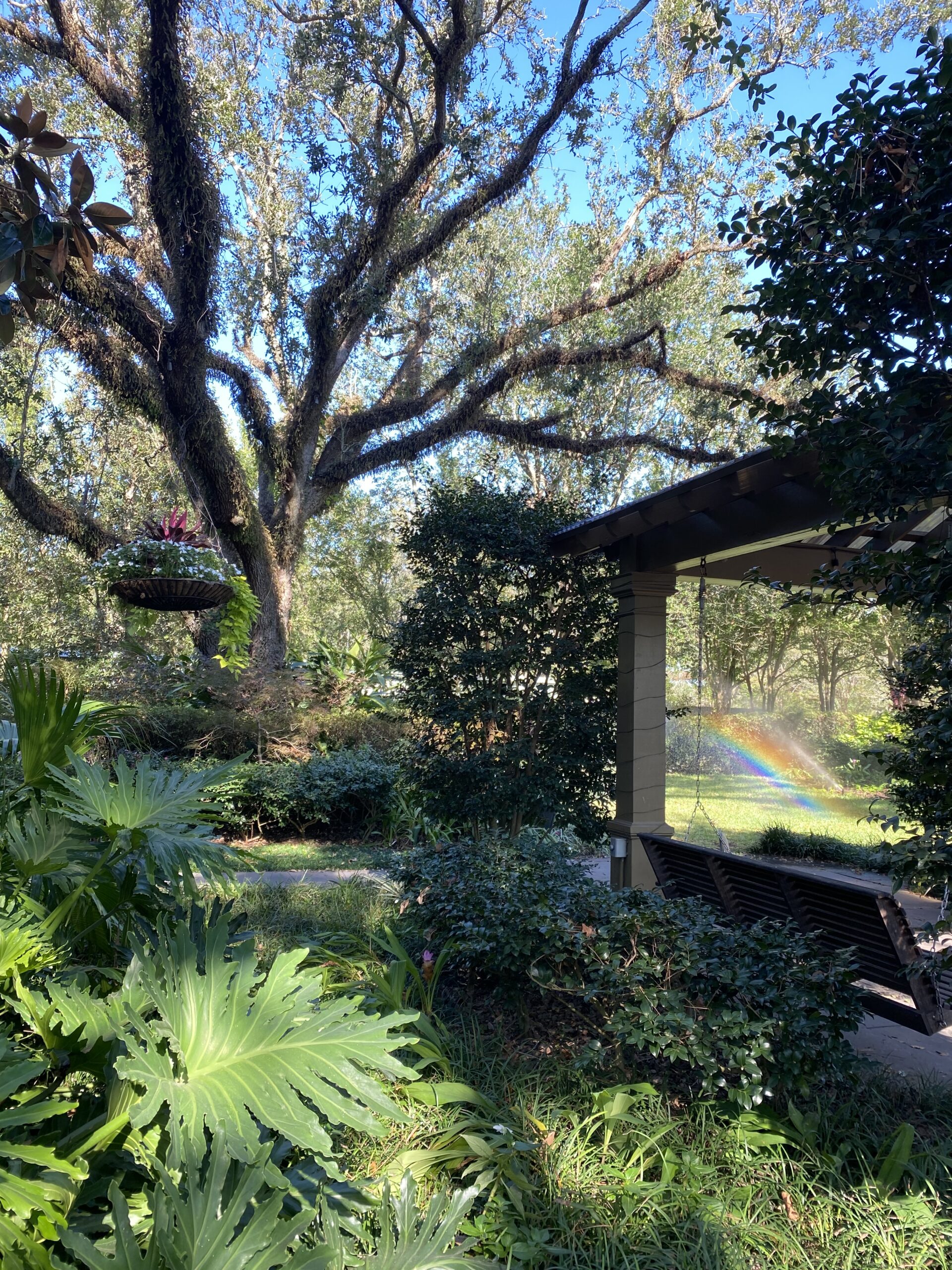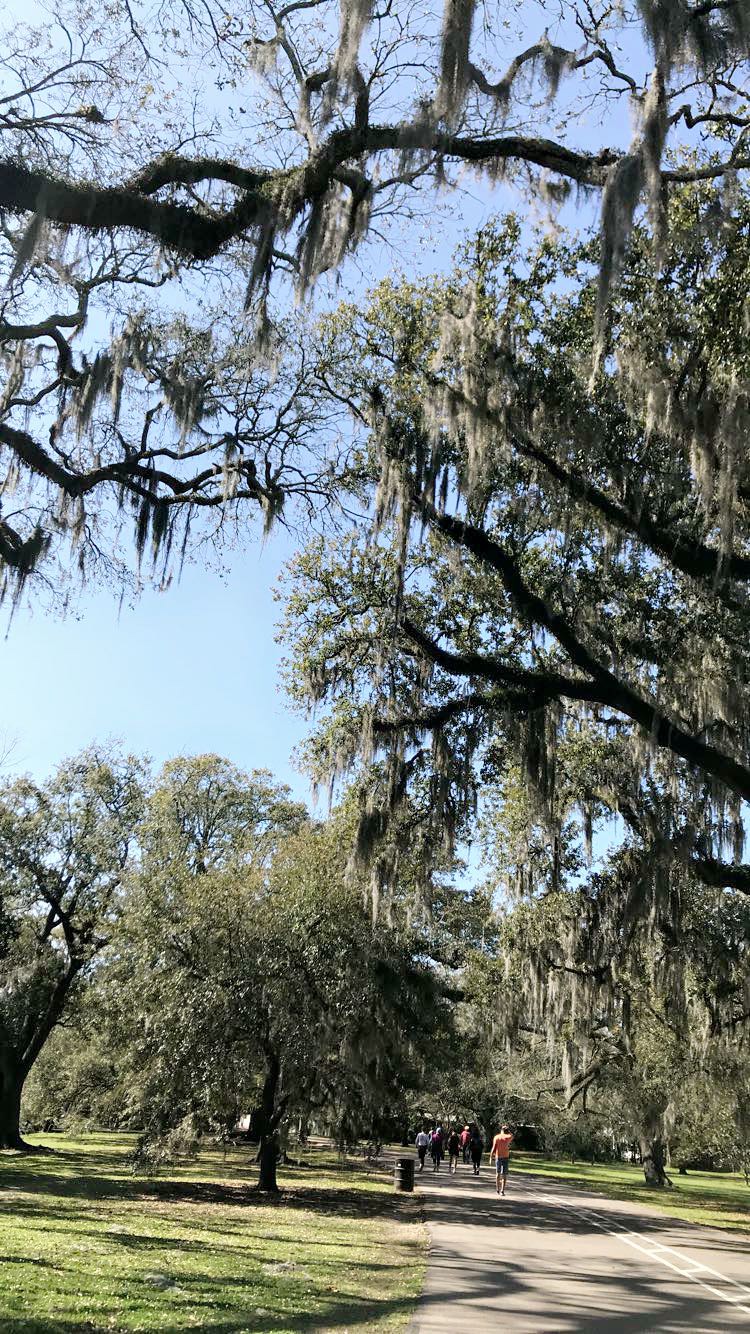
Hidden Gen-Meditation Garden at Audubon Parkt (Photo: Dani Marcus)
Audubon Park is a pill. A utopic capsule of the natural world, sandwiched between St. Charles Avenue and the Mississippi River, filled with sprawling oak trees, spanish moss, and vast ponds whose flows mimic the breath of life. It would seem that these, along with thousands of animal and insect species would cause the capsule to burst at its seams, yet nevertheless the bounds are limitless as it can somehow always welcome one more visitor. The very center of the park showcases a rolling golf course, and the aforementioned water-bodies. Encompassing these, is a seemingly infinite loop of pavement that is nestled within a vast ring of forestry.
Those who visit Audubon park, that “take the pill” are likely to feel its medicinal effects almost instantly. The Biophilia Hypothesis suggests an innate human draw to living things or things that mimic lifelike qualities, which is the entire basis of nature. Since it has been found that biophilia and increased exposure to living things often facilitates achievement of individual meaning and personal development, being in a park with plants and animals can have this same effect. As demonstrated in Maslow’s hierarchy of needs (with the base needs being food, shelter, and physical), one’s struggle with self-comfort becomes increasingly difficult as one progresses towards self-actualization, and addressing how someone feels about their own company is the first step in increasing comfort within oneself. Exploring the idea of solitude in conjunction with Maslow’s ideals, it becomes clear that it is not until one fully conquers the early levels of need, that they will be able to self actualize and be fully comfortable on their own, and with their own.

Audubon paved loop-featuring sprawling oaks (Photo: Dani Marcus)
Audubon Park, like others strategically placed in bustling urban areas, was established as space for self-improvement. This is largely due to the fact that being in the presence of plants and animals is said to awaken attention, and act as a leveling ground for all social classes. Many people circulate the path each day by foot, bike, board, wheel, and most importantly four legs. All of these odds and ends of individuals are contained together in a space surrounded by nature that becomes a community, even if only for a moment in time. Framed by oaks and sunbeams, the endless loop of pavement is an ever-turning carousel that switches out a few riders each time around. Anyone can be part of the ride if they so desire. The park, give or take a couple of training athletes and squirrels can be divided into 2 categories; those who are lonely, and those who are trying to work towards being comfortable and happy alone. There is some crossover between these two sections as the line is rather fluid in where one meets the other. Studies show that living in a city as opposed to a rural area raises the risk of depression by up to 40%, anxiety 20%, and makes community members twice as likely to suffer from Schizophrenia. Thus, society does what it can to find ways to cope. This is where the idea of biophilia comes into play, which is why parks are often found as oases amidst cities, like Central Park in New York City. In addition to trees removing toxins from the air, and parks providing a free space to exercise which improves public physical health, being around nature fulfills the innate human desire to be in company. One is never alone in a park, despite the number of people that may or may not be present.
Parks like Audubon are valuable resources for those trying to work towards self growth and comfort in one’s own company, be by themselves as it provides a place to be in intentional solitude in order to work on compartmentalizing issues. These don’t have to be life-dependent problems, but can be as mundane as thoughts and reflections. This works by combining the comfort found by being around life-filled organisms found in parks, as well as the mixed-bag of company that one can choose to never interact with, while still taking comfort in its presence. Since there are very few durations of substantial length in which people in today’s society are not connected to a network of relationships in one way or another, the practice of being alone can be a daunting task that takes time and getting used to before mastering it. Getting comfortable with the idea of unplugging can turn alone time into something which offers comfort and self discovery. It can boost memory, awareness, and relieve anxiety which are all stimulated by being in nature as well.
Audubon Park offers a unique blend of remote nature, and human reality. Located on St. Charles, a high traffic area in uptown New Orleans makes it very easy to access. It allows park-goers to feel the wellness effects that being in nature provides, without having to travel far off the beaten path. The user shapes their own experience; they can waste away the entire day there, or escape for a quick lunch break. As a pressing factor of mental health, loneliness poses a threat to people’s lifespans. Studies show that people who identify as introverts might prefer the company of nature, to people with whom they have to interact, or at the very least require time in nature to heal and recharge their social battery. It is also not uncommon for people with trust issues or who have been wronged many times to feel more comfortable being in nature, because trees can’t lie or cheat or plot. People of all ages take advantage of the healing effects of Audubon park. Spending time watching these people makes it tempting to create stories about their lives, compiling characters in the story of life. This is a practice that can help ease loneliness by providing distraction and stimulation for the mind.
As a collective, the public has a wide array of hobbies and pass-times. Rollerblading, journaling, meditating, some frequently observed behaviors in the park can suddenly become more appealing due to the power of suggestion – in a sense, giving a sort of direction that a lonely person might feel they lack. The power of suggestion increases awareness, and is said to lead to the possibility of more positive outcomes in one’s life. Membership in the Audubon “community” allows for influence by those around you, and seeing activities (no matter how obscure) bringing people joy tempts on-lookers to wish the same for themselves. And so is the idea of the community where people engage in lonesome activities, together. Whether what one seeks is to numb the mind, to catch up with a friend, or to solve life’s problems like equations, Audubon is a public space that has proven beneficial, and is reminiscent of medicinal qualities.
 NOLAbeings Multimedia artist Claire Bangser created NOLAbeings as a portrait-based story project that marries...
NOLAbeings Multimedia artist Claire Bangser created NOLAbeings as a portrait-based story project that marries...  Voodoo in New Orleans: Reviving history: New Orleans fortune telling This article takes a deep dive into the history of Voodoo in New Orleans, its hybridization with Catholicism, and its present-day place in the city's culture. The author visits fortune-tellers in the French Quarter, using their guidance as a tool for introspection rather than a deterministic predictor of the future. Through her experiences in New Orleans, the author feels a mystical connection to both the past and the future.
Voodoo in New Orleans: Reviving history: New Orleans fortune telling This article takes a deep dive into the history of Voodoo in New Orleans, its hybridization with Catholicism, and its present-day place in the city's culture. The author visits fortune-tellers in the French Quarter, using their guidance as a tool for introspection rather than a deterministic predictor of the future. Through her experiences in New Orleans, the author feels a mystical connection to both the past and the future. 